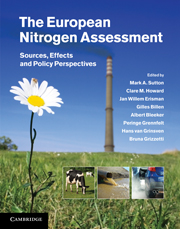Book contents
- Frontmatter
- Contents
- List of contributors
- Foreword
- Summary for policy makers
- Technical summary
- 1 Assessing our nitrogen inheritance
- Part I Nitrogen in Europe: the present position
- Part II Nitrogen processing in the biosphere
- Part III Nitrogen flows and fate at multiple spatial scales
- 10 Nitrogen flows in farming systems across Europe
- 11 Nitrogen flows and fate in rural landscapes
- 12 Nitrogen flows and fate in urban landscapes
- 13 Nitrogen flows from European regional watersheds to coastal marine waters
- 14 Atmospheric transport and deposition of reactive nitrogen in Europe
- 15 Geographical variation in terrestrial nitrogen budgets across Europe
- 16 Integrating nitrogen fluxes at the European scale
- Part IV Managing nitrogen in relation to key societal threats
- Part V European nitrogen policies and future challenges
- Glossary
- Index
- References
14 - Atmospheric transport and deposition of reactive nitrogen in Europe
from Part III - Nitrogen flows and fate at multiple spatial scales
Published online by Cambridge University Press: 16 May 2011
- Frontmatter
- Contents
- List of contributors
- Foreword
- Summary for policy makers
- Technical summary
- 1 Assessing our nitrogen inheritance
- Part I Nitrogen in Europe: the present position
- Part II Nitrogen processing in the biosphere
- Part III Nitrogen flows and fate at multiple spatial scales
- 10 Nitrogen flows in farming systems across Europe
- 11 Nitrogen flows and fate in rural landscapes
- 12 Nitrogen flows and fate in urban landscapes
- 13 Nitrogen flows from European regional watersheds to coastal marine waters
- 14 Atmospheric transport and deposition of reactive nitrogen in Europe
- 15 Geographical variation in terrestrial nitrogen budgets across Europe
- 16 Integrating nitrogen fluxes at the European scale
- Part IV Managing nitrogen in relation to key societal threats
- Part V European nitrogen policies and future challenges
- Glossary
- Index
- References
Summary
Executive summary
Nature of the problem
Observations of atmospheric reactive nitrogen (Nr) deposition are severely restricted in spatial extent and type. The chain of processes leading to atmospheric deposition emissions, atmospheric dispersion, chemical transformation and eventual loss from the atmosphere is extremely complex and therefore currently, observations can only address part of this chain.
Approaches
Modelling provides a way of estimating atmospheric transport and deposition of Nr at the European scale. A description of the different model types is provided.
Current deposition estimates from models are compared with observations from European air chemistry monitoring networks.
The main focus of the chapter is at the European scale; however, both local variability and and intercontinental Nr transfers are also addressed.
Key findings/state of knowledge
Atmospheric deposition is a major input of Nr for European terrestrial and freshwater ecosystems as well as coastal sea areas.
Models are key tools to integrate our understanding of atmospheric chemistry and transport, and are essential for estimating the spatial distribution of deposition, and to support the formulation of air pollution control strategies.
Our knowledge of the reliability of models for deposition estimates is, however, limited, since we have so few observational constraints on many key parameters.
Total Nr deposition estimates cannot be directly assessed because of a lack of measurements, especially of the Nr dry deposition component. Differences among European regional models can be significant, however, e.g. 30% in some areas, and substantially more than this for specific locations.
- Type
- Chapter
- Information
- The European Nitrogen AssessmentSources, Effects and Policy Perspectives, pp. 298 - 316Publisher: Cambridge University PressPrint publication year: 2011
References
- 18
- Cited by



